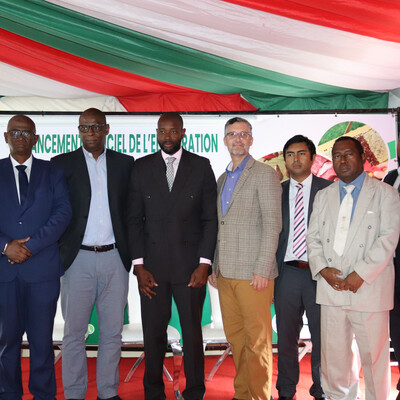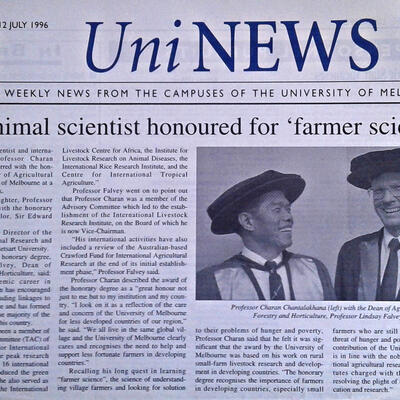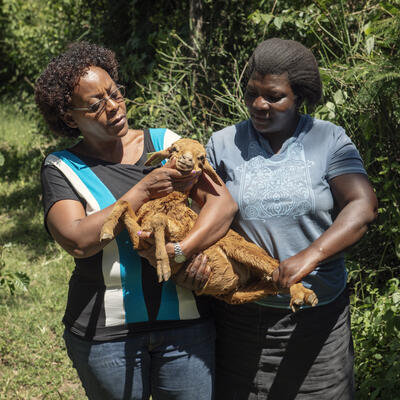
Building the business case for smallholder poultry development (part 2): Imagining ‘ACGG+’
In the course of 2018, the African Chicken Genetic Gains (ACGG) project team held an important meeting in Arusha, Tanzania (May 23-24) in order to capture the ‘business case’ for smallholder poultry development at large, building upon key lessons from ACGG so far, and looking into options for a potential ‘ACGG+’ follow-up program.
The 24 participants that took part in the workshop discussed the broad development outcomes and contours of ACGG+.
Among participants, there was a consensus that the genetics gains component of ACGG should be accompanied by systematic and deliberate push and pull strategies.
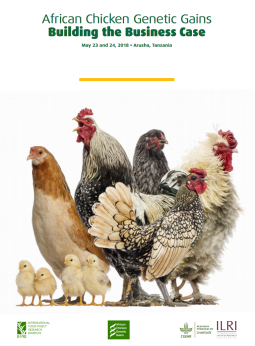
Cover of the African Chicken Genetic Gains: Building the business case report (photo credit: ILRI).
The push strategy centres on equipping smallholder chicken farmers with the necessary skills and expertise to raise the productivity of their poultry farm enterprises and have access to competitive input and output markets.
The pull strategy aims to lower entries to market for smallholder producers (through risk sharing investment mechanisms), strengthen capacity of middle level value chain actors to break bottlenecks in the value chain between commercial areas and more impoverished geographic areas; and, work towards reforming policies and regulations that hinder competitiveness.
New investment areas, new partnerships?
Key opportunities that emerged from the discussions at the workshop included a range of new or increased investment areas:
- Ensuring genetics innovation remains a core business.
- Making ACGG+ more nutrition-sensitive will be essential. Some suggested aligning the project more clearly with the CGIAR Research Program on Agriculture for Nutrition and Health (A4NH).
- Making technical, managerial and institutional capacity development in the delivery of genetic gains central in the next phase.
- Giving more emphasis towards women’s empowerment, creating a functioning poultry value chain, and an evidence-based biodiversity policy environment.
Key opportunities in the new phase will also comprise slightly modified partnership and engagement modalities.
The private sector actors have said they do not expect ACGG+ to keep investing in poultry genetics. But in order for ACGG+ to succeed, private sector involvement in the chicken value chain will need to be strengthened and requires a higher degree of engagement than has been achieved so far.
In addition, public-private partnerships will have to be catalysed to take tested and farmer-preferred chicken strains to market. From that point on these partnerships can help develop a market-led, stable and profitable smallholder chicken value chain for improved income and nutrition of sub-Saharan smallholder poultry keepers (especially women).
Participants also recommended that ACGG+ engage directly with policymakers (rather than operate systematically through innovation platforms) in order to show evidence gathered. The existence of a conducive policy environment, availability of national strategies e.g. those encapsulated in the country Livestock Master Engagement plan (such as in Ethiopia and Tanzania) etc., can serve as entry points in engaging with policymakers.
Moving agricultural technologies to markets: a 10-step pathway from discovery to delivery, and a framework for action
A 10-step pathway was introduced that could help the program define its business case and move away from the blue sky ‘discovery’ research to the ‘research-in-development’ delivery impact: The steps are:
- Understanding market opportunities
- Availing the proposed solutions
- Technology description
- Identifying impact pathways
- Ecosystem mapping of technologies and geographies
- Undertaking evidence-based benefits’ analysis
- Identifying partnerships for delivery along the value chain
- Investments
- Strategy and stage plan
- Making the business case
Along these lines, a programmatic framework was suggested. Finally, the participants also came up with a tentative vision statement for ACGG+, based on all the above deliberations:
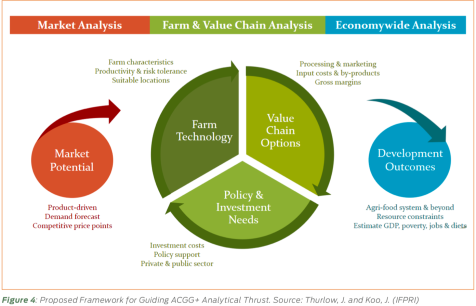
Proposed Framework for Guiding ACGG+ Analytical Thrust. Source: Thurlow, J. and Koo, J. (image credit: IFPRI)
Catalyse public-private partnerships to expand genetic gains from tested as well as farmer-preferred chicken strains and develop a market-led, stable and profitable smallholder chicken value chain for improved income and nutrition of smallholder poultry keepers, especially women, in sub-Saharan Africa
Many months remain until the new program shapes up but a lot of work is going into preparing for ACGG+.








